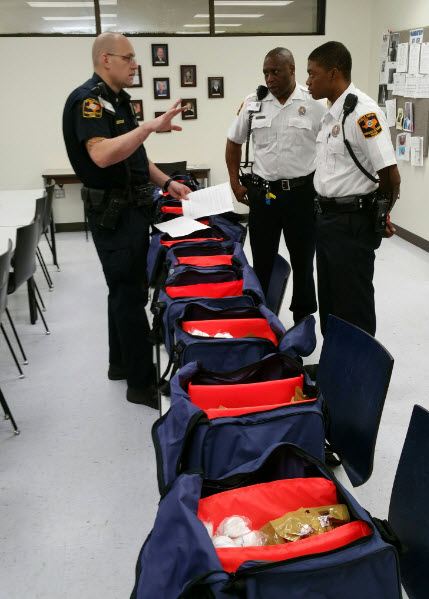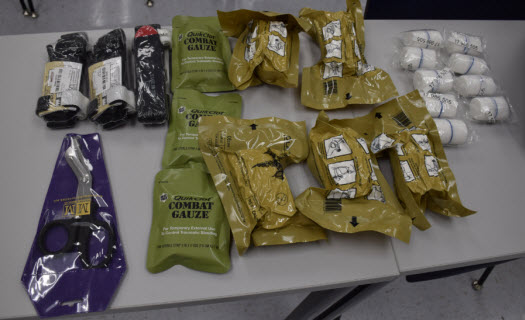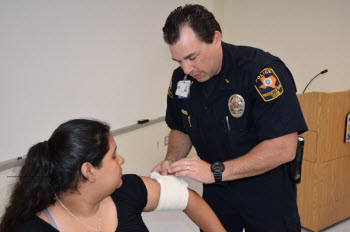
Prepare for the worst and hope for the best. That’s Lt. David DeOre’s philosophy.
Over the past several years, it’s been hard to escape media coverage of horrific events like the mass shooting at Sandy Hook Elementary or the Boston Marathon bombings. While we all hate to imagine anything like that happening close to home, DeOre and the rest of the UTMB Police Department want to be prepared to step in and provide emergency medical care if needed.
That’s why they have created mass-casualty kits to be placed in public areas around the UTMB Galveston campus. Originally presented to the Business and Finance Leadership Academy Graduation in November 2014 by DeOre and his colleagues, the kit is designed to be used by police during an incident where paramedics can’t immediately access the injured due to safety restrictions.
“In active-shooter scenarios, police officers are often the first to arrive on the scene. While police generally do a good job eliminating the threat, the downfall comes with treating the victims before medical personnel get there,” said DeOre. “We first saw this with Columbine – EMS and Fire had to wait until police cleared the building and deemed it safe to enter. Well, while they waited, many of the victims bled out and it was too late. So if we as police can take care of the bad guy and also take it a step further and start triaging those individuals until paramedics arrive on scene, more lives could be saved.”
DeOre says all of his officers currently carry a compression bandage and tourniquet, but a kit could provide them with enough supplies to treat multiple victims. At $275 a kit, the supplies are similar to what soldiers use for combat situations. Each duffel bag includes three tourniquets, packages of quick-clot gauze, scissors and bandages. While the supplies are basic, DeOre says it can go a long way.
supplies to treat multiple victims. At $275 a kit, the supplies are similar to what soldiers use for combat situations. Each duffel bag includes three tourniquets, packages of quick-clot gauze, scissors and bandages. While the supplies are basic, DeOre says it can go a long way.
“In cases of massive bleeding, victims have only a small window of time in which they must receive first aid before the blood loss becomes life-threatening,” said DeOre. “These small items can quickly control bleeding and keep victims from going into shock before professional medics take over.”
According to the National Trauma Institute, hemorrhaging is responsible for more than 35 percent of pre-hospital deaths and 40 percent of deaths in the first 24 hours after a traumatic injury. Military officials consider hemorrhage as the No. 1 preventable cause of death on the battlefield.
Twelve kits have been placed on the first floors of buildings across the Galveston campus, in areas that are easily accessible to  police, including Levin Hall, the Rebecca Sealy building and the John Sealy Hospital.
police, including Levin Hall, the Rebecca Sealy building and the John Sealy Hospital.
The UTMB Police Department is just one of a growing number of law enforcement agencies across the nation to issue trauma kits and train officers about emergency medical care.
“Hopefully we never have to use these, but it’s always best to plan ahead and be prepared for any situation,” said DeOre.